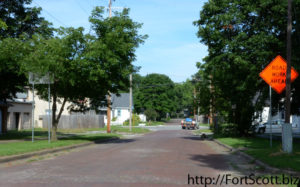During their first June meeting held Tuesday evening, the Fort Scott City Commission approved of the 2016 street improvement program, but also discussed that department’s need for further revenue sources in future years.

Finance Director Jon Garrison said the budget will be sufficient for the next year or two, but by 2018 the city may have to find other ways to fund the street department as it continues to use up carryover finances, becoming a “major concern” financially.
City Manager Dave Martin said the need for street repairs is great in Fort Scott and the city could benefit from spending $300,000 to $400,000 on projects each year to keep ahead of that need. The 2016 program approved Tuesday was for a total of $130,429 in improvements, as presented by Streets and Traffic Supervisor Chad Brown.
“It’s not unique to Fort Scott,” commissioner Jim Adams said of the need for repairs, saying he frequently hears from residents listing areas that need repaired.
Garrison said the department is currently funded annually by the gas tax, which brings in about $225,000 from the state annually, and $400,000 from the city’s general fund. Options for other revenue sources could include earmarking a portion of the sales tax for the street department, reallocating existing resources or continuing taxes such as the pool tax that will sunset in upcoming years, instead using that amount of about $675,000 a year for street maintenance and repairs.
The improvement plan the commission approved includes 11 projects, five of them road projects and the other six off-street parking projects.
Road projects include 9th, 10th and 11th streets between Main Street and National Avenue, Judson Street from 1st to 2nd Street and the intersection at 8th and Wilson streets.
Two of the road projects, at 10th and 11th streets near the high school, will include taking up about two blocks of brick roads and replacing it with asphalt, which Brown said is a quicker and much cheaper process. Commissioner Randy Nichols said he realizes the brick roads are an important part of the historic downtown community, but the area for the project is outside that designated historic area and will benefit those driving around the high school.
Parking areas are included in the program at areas that need consistency where surfaces are currently made up of asphalt, concrete and brick as well as improvements in order to make them safer for pedestrians who have tripped or fallen on uneven areas.
“Parking is becoming more critical as we continue to improve downtown,” Martin said. “And these parking lots haven’t had anything done to them for quite a few years.”
Brown also gave an update on the city’s use of the new pothole patching equipment, used since the beginning of the year. It has been used for a total of about 135 tons of patching material at the cost of just over $3,400, saving the city almost $15,000.
“That’s a tremendous asset to us,” Brown said of the machine, which has saved the city employees time and efficiency as well as money.
